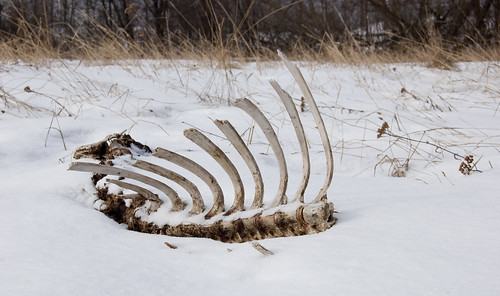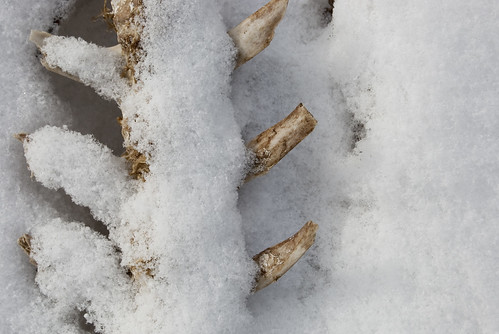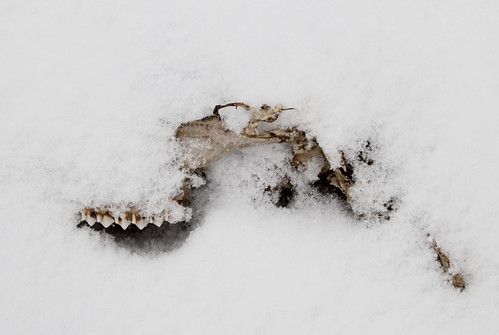
It was the jaw of a deer, resting atop the snow. It was peculiar, sitting there by itself -- and I retrieved it. A few feet away, I soon found what I recognized to be the very tips of a ribcage poking through the snow. I resisted digging them up right then; instead I circled the area, and about twenty-five feet away, I discovered the leg of the deer, reduced bone. Returning to the ribs, I started to uncover them, finding the entire ribcage attached to most of the spine, and at the end -- the skull. The skeleton of First January Deer belonged to a doe.

Unearthed, the skeleton was quite unattractive, encrusted with snow and ice. It still baffles me as to how the skull was several inches under the snow and yet the jaw was resting on top. After taking many pictures, I moved on, and soon found the other half of her spine, pelvis and a single leg attached. These bones, too, had been picked clean.
After completing a loop through the bog, I snowshoed closer inland, toward the road that circles the island. It was then that I found Second January Deer. The skeleton was at the base of a tree, most of the ribcage protruding through the snow, half of the skull showing, as well.

All around the skeleton were the tracks and wing-prints of the animals that had been here first. I dug up the skull, and found that it, too, belonged to a doe.
In the weeks that have passed since I initially found these two skeletons, I have visited them many times. Each time I visit, I see something new -- new tracks, new snow, new parts of the skeleton I didn't see before. The amount of snow obscuring the bones constantly fluctuates. The first few sets of photographs I took greatly displeased me and I decided I'd continue to photograph the skeletons until I produced pictures that I truly liked.
About two and a half weeks after I'd found the January Does, I finally made some satisfactory photographs. It had snowed, and the skeleton of First January Deer was partially obscured again. Her body was no longer surrounded by my snowshoe tracks, instead the only signs nearby were that of the coyotes, mink, and crows who were depending upon her to survive the winter. I photographed the skeleton slowly and deliberately, now quite familiar and comfortable with it.




I returned again, less than a week later, and even more snow obscured the skeleton of First January Deer. Her skull was almost completely covered.

The same day I paid a visit to Second January Deer; her skeleton hadn't changed much, but I did find her lower jaw, and a week earlier I had found the second half of her skeleton, close by but covered by snow and ice. It was interesting to me that her ribcage still had a good deal of stringy muscle hanging from it, but the skeleton of First January Deer was almost completely clean. Perhaps the second skeleton, being in such a close proximity to the road, deters larger animals from visiting? Still, the wildlife on Presque Isle seems to be quite used to the human presence there.

Having constant access to these two skeletons has been very important for me. As the snow falls and melts, I have been able to observe many changes to the bodies, and I've been able to see the tracks of the animals that have been feeding on them. I have also been able to photograph the skeletons as often as I like, taking as much time as I like. It's greatly improved my photography in just as little as a month! Having these deer there to come back to every weekend allows me to experiment with different angles and compositions, things I might not try when coming upon a dead animal that I'll most likely see only once. I've become very familiar with these skeletons, especially that of First January Deer, and she's grown on me considerably.
So far no one has moved the skeletons. I'm not afraid of that happening in the winter, when hardly anyone visits the bog, but come spring when the snow melts, there's a chance they might be removed and suffer the same fate as April Deer. Until that happens, though, I'll continue to visit them and photograph them weekly.
This week, First January Deer's skeleton was unburied once more, and surrounded by many crow tracks. As I investigated the scene, four does watched cautiously.




Beautiful writing and photos, Marjorie. Mom
ReplyDelete